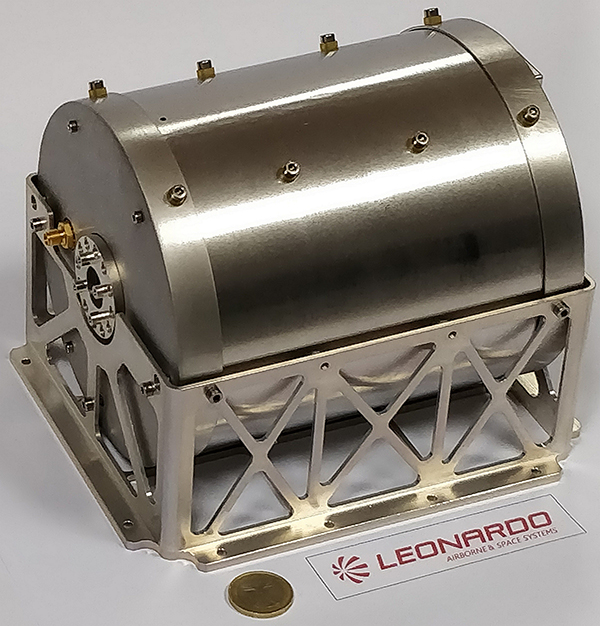What do astronomical navigation and satellite navigation have in common? The need to locate a position with precision.
Now, think back 20 years, when satellite navigation was not available. How could we locate a ship’s position in the open sea, far from any landmark? At least 20 minutes were needed to confirm the vessel’s location through several calculations based on the stars being 90 degrees from each other, and then measuring the stars’ distance from the horizon. Today, thanks to satellite navigation, we can identify a ship’s position to within 30cm and in real-time! Since clockmaker John Harrison invented the marine chronometer in 1761, the secret to determining a position is knowing the exact time.
Leonardo’s adventure in this area began in 1999, when the European Space Agency (ESA) wanted to equip the Galileo Global Navigation Satellite System (GNSS) with first generation atomic clocks. Our main challenge, apart from building the hydrogen clock, was to make it adequate for space flight. During the launch phase, it had to be mechanical stress resistant and in space it had to resist cosmic radiation bombardments in the atmosphere which could damage the electronic components.
In 2005, the first Leonardo atomic hydrogen clock passed all the tests, and in 2008, it was launched for the first time on-board GIOVE-B, the first Galileo experimental satellite. Following GIOVE-B’s success, the European Community funded development of the full GNSS, with each satellite carrying the Passive Hydrogen Maser (PHM) created by Leonardo in Nerviano. Today, PHM is the most stable and precise atomic clock ever produced for space application.
The Galileo constellation consists of 30 satellites in Medium Earth Orbit. Designed to work in space for 12 years, the atomic hydrogen clocks represent the real core of the Galileo constellation, guaranteeing the correct functioning of the system. With an error of one second every three million years, the atomic clocks each weigh 18kg and consume 60W per hour, equivalent in power consumption to an incandescent light bulb.

What is an atomic clock and how does it work?
The atomic clock is a type of clock in which the time base is determined by an atom resonance frequency, which generates a period signal characterised by an extremely stable and reliable frequency. More specifically, the Leonardo PHM uses the “MASER” (Microwave Amplification by Stimulated Emitted Radiation) effect. Inside the atomic clock, we find two fundamental elements: an oscillator, and an atomic resonator which serves as a frequency discriminator. The oscillator produces the “tic-tac” of the clock, and, at the same time, generates and sends an electromagnetic wave to the atomic resonator. In simple terms, we could say that this operation is comparable to the tuning of a guitar with a diapason, where the guitar is the oscillator and the diapason is equivalent to the atomic resonator.
In the near future, we will need clocks that are provide even greater performance and are more compact and precise, not only for the satellite navigation, but also for the autonomous navigation of vehicles to explore deep space, or perhaps, conquest Mars in 2030. For this reason, Leonardo is already working on the next generation of the Galileo clock. This will involve miniaturising the PHM – which has seen us reduce the clock’s volume by 22%, its mass by 34% and power consumption by 35% – while maintaining the same stability of the model that is flying on Galileo.
What is the future of the atomic clock?
Leonardo, in collaboration with the Turin INRIM (Istituto Italiano di Ricerca in Metrologia) is developing a futuristic project – a Rubidium atomic clock named Rb POP (Pulsed Optically Pumped). It is an innovative technology for space, with performance similar to that of the PHM, which uses the POP technique. Furthermore, for this new project, Leonardo used its knowledge and experience gained from creating the PHM, to design and build Rb POP’s physical unit too, besides the electronic and optical units, making the clock entirely produced by Leonardo and fully made in Italy. Currently Leonardo has completed the development of the physical unit of the clock and is developing the optical and electronic units, thus completing the development of the entire clock.
What is this precision needed for, and why?
In satellite navigation systems such as Galileo or the American Global Positioning System (GPS), time measurement is fundamental. Since the signals propagate at the speed of light, an error on the flight time in only a millionth of a second would result in error of position of 300 meters! This is why the clock’s precision is crucial to determine the location. Think, for example, of all the applications we use to search for a place or a position with Google Maps. With technological progress, it is absolutely essential for clocks to be precise and stable.
The Galileo programme
Galileo, the European satellite navigation and location system, is interoperable with the American GPS and the Russian GLONASS satellite navigation systems. In particular, Galileo guarantees both positioning and navigation services accessible to all for free, and ad-hoc services for specific applications, such as the safety of air transport, maritime and rail transport, and the banking, energy, insurance, telecommunications, tourism and agricultural sectors.

